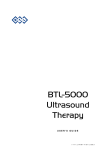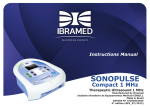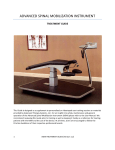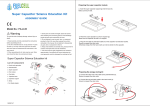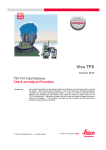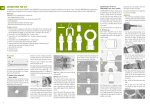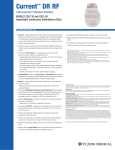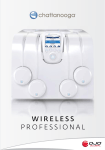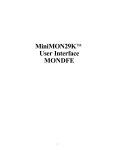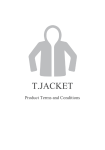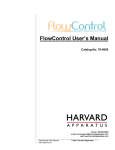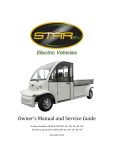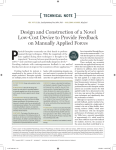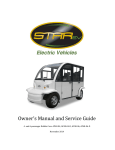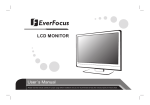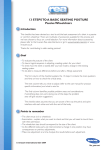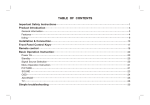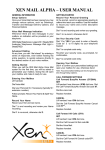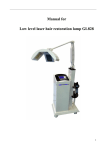Download ASMI - Advanced Therapy Systems
Transcript
The Advanced Spinal Mobilization Instrument (ASMI) Sales Guide Table of Contents 1. The Advanced Spinal Mobilization Instrument (ASMI) Pg. 1 2. What is Spinal Mobilization? Pg. 2 3. How is the ASMI different? Pg. 2-3 4. ASMI, A Unique Treatment Pg. 4 5. Benefits of the ASMI Pg. 5 6. Sample Introductions Pg. 6-7 7. Qualifying Prospects for ATS Pg. 8-9 8. Frequently Asked Questions Pg. 10 9. Objection Handling Pg. 11-12 10.Quotation Example/Return on Investment (ROI) Pg. 13 11.Sales Tools Pg. 14 Addendums A. ASMI Demonstration Guide Pg. 15 B. Outline: Practitioner Training Program Pg. 16 C. ASMI Treatment Guide Pg. 17-24 D. Manual Forces Applied During Posterior-to-Anterior Spinal Mobilization Pg. 26 E. ASMI Treatment Contraindications, Precautions, Indications Pg. 27-28 1.The Advanced Spinal Mobilization Instrument (ASMI) What is the ASMI? The Advanced Spinal Mobilization Instrument (ASMI) is the only power assisted manual therapy tool used to treat the entire spine. The ASMI system components are: The ASMI handset, console, mobile treatment table, and air compressor How is the ASMI used? The ASMI is used to adjust, mobilize, or manipulate the musculoskeletal joints of the spine. The ASMI was designed to act as an extension of the hand, combining precise spinal mobilization with infinitely variable control. Using techniques already known to the practitioner, the ASMI was developed to deliver treatment to the entire spine with a consistency and effectiveness far superior to manual techniques. What is the ASMI used to treat? Multiple spinal dysfunctions Reduction or elimination of back and neck pain Restored spinal mobility and flexibility Recovery from back injuries Muscle relaxation Posture and back health 2. What is Spinal Mobilization? Spinal mobilization is a type of gentle, passive movement applied manually to a spinal region or segment so as to gently increase the range of motion of that segment or region. Spinal mobilization employs a range of techniques or approaches in delivering this passive movement. Some examples include the Maitland and Mulligan techniques with the use of your fingers or hands. Advanced Therapy Systems Page 0 of 35 The earliest practice of manual therapy dates back to Hippocrates in 460 B.C... Spinal mobilization as a physical therapy technique became widely accepted in the early 1950′s. One of the most eminent manual therapists at that time was Geoffrey Maitland, PT. As taught by Maitland, spinal mobilization is a passive movement through the range of motion of the spinal or vertebral articulation. Today his and other manual techniques have become an important part of the curriculum in most schools of physicians and physical therapists. 3. How is our Advanced Spinal Mobilization Instrument (ASMI) different? The ASMI is an air powered medical device used to adjust, mobilize, or manipulate the musculoskeletal joints of the spine. The ASMI was designed to act as an extension of the hand, combining precise mobilization with infinitely variable control. Unlike the hand, however, the instrument was developed to deliver treatment for a longer period of time, more powerfully and at much quicker speeds than an individual practitioner could ever hope to achieve manually. The inconsistency in manual force application (see Addendum D) during Posterior/Anterior (PA) spinal mobilization in existing studies suggests that further studies are needed to improve the clinical standardization of manual force application. Future research on mobilization should include forces applied to the cervical and thoracic spines in addition to the lumbar spine while thoroughly describing force parameters and measurement methods to facilitate comparison between studies. The handset incorporates four pads powered by variably controllable electro-pneumatics. These pads operate in opposing pairs and are spaced so as to align with the vertebrae. The treatment is delivered in three modes, a spasm mode, a reflex mode and the mobilization mode. Each mode is used throughout the treatment depending on the patient’s condition as determined by the practitioner. Advanced Therapy Systems Page 1 of 35 Below is a chart showing the differences and benefits between TSM and PASM. Traditional Spinal Mobilization (TSM) Power-Assisted Spinal Mobilization (PASM) Treatment Table Flat surface Curved table design provides gentle lumbar traction and opens the vertebrae. Cervical Support None Free moving leaf spring headrest design prevents cervical compression and provides comfort to patient. Applicator Hands Pneumatic handset device with four pads spaced to align with the spine. Treatment Area Target affected areas only. Treat the entire spine utilizing three distinct treatment modes that provides Myofascial Release, Neuromuscular Re-education and Spinal Mobilization. Treatment Mobilization – manual force is applied to move only the affected vertebrae. PASM operates in three modes and provides for a comprehensive treatment: 1. Spasm Mode (Myofascial Release) - relaxing spasms and acclimating the patient to the feel of the treatment. 2. Reflex Mode (Neuromuscular Re-Education) stimulates spinal muscles to support and stabilize the cervical, thoracic, and lumbosacral paravertebral muscles. 3. Mobilization Mode - gentle force is applied to the alternating transverse processes of adjacent vertebrae (counter rotating each pair of vertebrae at a time) along the entire spine with consistent frequency. PASM provides relief over a long term period, and can help prevent/limit the extent of potential future injuries. Duration 12 to 15 minutes per vertebral joint and ranges between 2 or 3 joints per session. However, the times may vary with patient diagnosis. Advanced Therapy Systems Sessions last approximately 15 minutes, treatment is applied over the entire spine not just the affected area. The device applies consistent pressure and frequency which generally provides for consistent treatment times, however, the times may vary with patient diagnosis. Page 2 of 35 4. ASMI, A Unique Treatment: The ASMI is used to apply pressure to the diagonally opposite transverse processes of neighboring vertebrae. The condition of the joint determines the response to the applied effort. Initially the joint may be fixed or out of alignment. The goal of the treatment is to restore alignment, flexibility and mobility to the joint and restore the para vertebral muscles that support and stabilize the spine. The specially designed, touch sensitive handset enables practitioners to feel movements of the individual vertebra. It is important to note that this treatment is sometimes impossible to do manually because the spinal joints are bigger and tougher than the practitioner’s hands. There are many treatments available for back pain but with the ASMI, practitioners can work on the entire spine. Positive results can be achieved in the first treatment with long term results achieved in 5- 10 sessions on average. Treatments are performed with patients lying prone or face down on a specially designed treatment table. A SPASM mode always begins and ends a treatment, relaxing the patient and acclimating them prior to the beginning of the treatment. In the REFLEX mode the alternating pads provide short taps to the paravertebral muscles. These muscles run parallel to the spine from the base of the skull to the tailbone, and provide stability and support the spine at rest and during movement. The Reflex mode stimulates the muscles of the cervical, thoracic, and lumbosacral paravertebral muscles that may have been shut off due to injury, poor posture, or inactivity. The third and therapeutic phase of the treatment is the MOBILIZATION mode. Gentle force is applied by the handset applicators that applies pressure to the alternating transverse processes of adjacent vertebrae (see AB model). This produces a counter rotational movement of each vertebral pair and increases the mobility and alignment to the spine. This mobilizing movement allows the body to release its natural synovial fluid to each facet joint (the same fluid found in your knee or elbow joint) Skilled practitioners will recognize resistance of stiff or immobile joints and will focus on returning mobility and flexibility to these joints throughout the use of this mode. Treatment sessions lasts for approximately 15 minutes, alternating between the Reflex and Mobilization modes, and finishes with the Spasm mode. Since the joints of the hands are smaller than the joints of the spine, we have developed a tireless, stronger and more precise tool to assist the practitioner in accomplishing the patient’s optimal range of motion in less treatment time. Advanced Therapy Systems Page 3 of 35 5. Benefits of treatment with the ASMI A Revolution in Spine Technology The Advanced Spinal Mobilization Instrument (ASMI) is the only power assisted manual therapy tool used to treat the entire spine. Our patented and FDA approved Advanced Spinal Mobilization Instrument is used by licensed health care professionals to treat multiple spinal dysfunctions. Treat back and neck pain more effectively and efficiently Resulting in the reduction or elimination of back and neck pain Restored spinal mobility and flexibility Faster recovery from back injuries Muscle relaxation Improve posture and back health Proven: Spinal mobilization with the ASMI has been proven to be extremely effective in treating many types on spinal injuries and as well as being an effective preventative against future spinal injuries Easier on practitioner hands, much less fatiguing allowing increased treatment volume. For Patients: Faster and longer lasting relief from spinal related pain and injuries with fewer treatments. Covered by insurance. For Practitioners: Improved patient results More customer referrals Increased patient volume The ASMI is a safe and effective tool to assist in the treatment of multiple spinal dysfunctions such as: Back and Neck Pain Sciatica Herniated / Bulging discs Cervical/Lumbar Radiculopathy Advanced Therapy Systems Multiple Sclerosis Parkinson’s Spinal degeneration Muscle spasms Fibromyalgia Osteo Arthritis Headaches Scoliosis Page 4 of 35 6. Sample Introductions: Telephone/In Person intro script. (Any script must be used in the words that you are comfortable with. That will come with practice). Hi/Hello, Thank you for taking my call. I'll be brief. Or, It is a pleasure meeting you, let me introduce myself I represent Advanced Therapy Systems. We are a medical device company that manufactures and markets a unique and patented technology dedicated to the treatment of back and neck pain. Our patented and FDA approved Advanced Spinal Mobilization Instrument (ASMI) is used by licensed health care professionals to treat multiple spinal dysfunctions. Clinical trials have proven dramatic patient improvement over existing technologies and methods. It is also covered by insurance plans. Are you the person that I should be speaking with? If no, can you please tell me who would be the best person to speak with? Thank you. If yes, is this a convenient time for us to talk for a few minutes? If no, skip to next page. If yes, Explain that the ASMI is an air powered medical device used to adjust, mobilize, or manipulate the musculoskeletal joints of the spine. It has been featured on Terry Bradshaw’s “Today in America” cable TV program. At this point you need to ask questions that will help you to understand the person’s current situation. Some common questions and answers include (see pgs. 7-11 for more): 1. The ASMI device allows you to treat the entire spine. 2. A full treatment consists of the following: a. Myofascial Release (SPASM MODE) b. Neuro-muscular Re-education (REFLEX MODE) c. Spinal Mobilization (MOBILIZATION MODE) 2 minute of Myofascial Release (SPASM MODE) 5 minutes of Neuro-muscular re-education (REFLEX MODE) 8 minutes of spinal mobilization (MOBILIZATION MODE) 3. Full treatment duration – with the ASMI, treatment time varies depending on the patient’s condition Effective treatment with ASMI: a. Consistency across each section of the spine b. Selective pressure & frequency setting (customize the treatment for the patient and their condition) c. Results in higher positive outcomes 4. Safe to use – application of the full treatment along the entire spine with the ASMI will reduce/eliminate the risk of developing hand problems such as arthritis, carpal tunnel syndrome, tendonitis, etc. which can occur in some practitioners over time a. Make sure you compare the full treatment of the entire spine assisted with the ASMI vs. hands alone b. With proper technique, no hands or fingers are directly touching the patient when applying treatment c. Built-in safety features ensure the device will not harm the patient i. Pressure is limited and released automatically when pre-determine force is met even when additional force is applied by the practitioner d. Applying the full treatment with the ASMI is safer than applying it by hands alone Advanced Therapy Systems Page 5 of 35 If no: When would be a good time for you to have some time for a more in-depth conversation? I’m thinking that it would be probably no more than 20 minutes. I could then tell you more about our company and our unique product and also answer any questions that you may have. Offer 2 days and times for a meeting. Prior to our meeting, I would like to send you an e-mail along with some additional information and a link to our Website. The Website includes Videos, Treatment overview, Testimonials, and Clinical Information. Optional: I can also schedule a short on-line presentation and depending on the audience, and make sure I have the appropriate people available on our end to answer questions. Thank you again for your time and I look forward to speaking/meeting with you soon. E-Mail intro script. I would like to introduce you to our company and our revolutionary product which has been featured on Terry Bradshaw’s “Today in America” cable TV program. Advanced Therapy Systems offers the Advanced Spinal Mobilization Instrument (ASMI), an FDA approved and patented medical device used by licensed health care professionals to treat multiple spinal dysfunctions such as Herniated/Bulging discs, back spasms among many other common back injuries. Spinal mobilization with the ASMI has been proven to be extremely effective in treating many types on spinal injuries and as well as being an effective preventative against future spinal injuries. Successful clinical experiences with ASMI are well documented. The ASMI is an air powered medical device used to adjust, mobilize, or manipulate the musculoskeletal joints of the spine. I would be pleased to have the opportunity to talk further with you or to someone you consider appropriate. I will follow up to determine when might be a good time for us to talk further. In the interim, I urge you to take a look at our Website http://www.advancedtherapysystems.com/ and view some of the videos under the “Media Tab” as well as some of the supporting clinical data. Advanced Therapy Systems Page 6 of 35 7. Qualifying Prospects for ATS Good prospecting and qualifying allows you to avoid wasting your time and precious resources. You need to weed out the long shots and concentrate your efforts on those prospects who are likely to yield a return on your investment of time, money, and energy. Prospects are true potential buyers. Suspects, on the other hand, are the people that can hijack your productivity. Good qualifying allows you to move a potential customer from being a Suspect to a prospect. Top salespeople are never desperate. Chasing suspects is as desperate as you can get and true prospects have a nose for that kind of thing. Qualifying prospects for ATS can be different than other products or services we may have experiences with in the past. One main difference, in my opinion, is that the ASMI is a new technology being introduced to your target base. This requires specific qualifying questions and techniques. To make a point, if we were selling printers or copiers we would not need to explain the advantages and benefits of this new technology. Have a clear vision of your ideal prospect. First step in prospecting and qualifying is to define the characteristics that we believe our best prospects will have. This will become an iterative process as we better understand what the best prospect profile is. This will let you focus on the prospects that closely match that profile. Let's look at what we have experienced as a good prospect profile. Your experience with prospects will add to this list as we expand the sales force. 1. Customer referral 2. Back and neck pain treatment industry 3. Physical therapists, Chiropractors, Physicians, and hospital rehabilitation clinics 4. Open to new techniques and technology 5. Geographically convenient to easily schedule frequent meetings with a prospect. 6. Proximity to demonstration location 7. Women practitioners seem to be more open to ASMI (stress on hands; hand & nail wear and tear) Standard good practice qualifying questions and techniques include: The goal of asking the customer questions is to get them to share with you information, and that is done by asking open-ended simple questions. The value of these questions is that they're likely to spark a conversation that will allow you to assess whether there's a real interest for what you're selling and a budget to buy it. Ask all the questions you need to ask to make sure that they truly have interest in what you offer, and they fit your ideal client profile. Advanced Therapy Systems Page 7 of 35 What role do you play in the decision process?" You'd be amazed by how many sales reps simply never ask this question and, instead, assume they are dealing with a decision maker. Who are the people typically involved in this decision making process? "How does this decision process work? Walk me through it." If you have a pipeline full of prospects who didn't buy after your demo or presentation, then you probably didn't ask this question either. And I'll bet your closing rate is less than 2 out of 10..... What are the concerns or roadblocks that could crop up down the road and get in the way of us working together? If you have a pipeline full of prospects who didn't buy, then you probably didn't ask this question. Who else in your company should I be presenting to and following up with? Based on what you've heard so far, how much of a fit do you think our ASMI would be for your practice? If you're dealing with a real buyer for your product or service, there is no better question than this one to uncover what any potential objections might be waiting for you. Is there anything you can think of that might stand in the way of us doing business if you like what you see?" This question is for Top 20% closers only and it's the question that will move you into the Top 1%. Try it and start re-qualifying or start writing up your order for the next call... Most people do not listen with the intent to understand; they listen with the intent to reply. Note: don't pepper the customers with questions like an interrogator giving a prisoner the "third degree." Work them into the conversation as you discuss a prospects current situation and response to your questions. Advanced Therapy Systems Page 8 of 35 8. FREQUENTLY ASKED QUESTIONS: What is the Advanced Spinal Mobilization Instrument ASMI? The ASMI suite includes the following components: ASMI Console & Handset, Air Compressor, Mobile cart, Portable treatment table. The ASMI handset operates with moving applicator pads that operate in three distinct modes. The pads gently move in and out in an alternating fashion and built-in safety features prevent the pads from overexerting pressure when the handset is placed on the patient’s back. How is this treatment different? The Advanced Spinal Mobilization Instrument is the only technology assisted device intended to duplicate the manual spinal mobilization technique performed by many medical practitioners. The device provides practitioners the ability to effectively and efficiently treat the entire spine. What are some of the benefits of ASMI treatment? Reduction or elimination of back pain Restored spinal mobility and flexibility Faster recovery from back injuries Muscle relaxation Who can operate the ASMI? Licensed Health Care Professionals only. Do I need to be trained to use the ASMI? Suite? Yes, to obtain the best results possible we provide onsite training to practitioners. How much does the ASMI cost? The ASMI is very affordable with multiple options for acquiring the device. On site demonstrations and trial periods for the ASMI are also available. How are we going to make the prospect’s world better? Better results, increased business, ROI, covered by insurance plans. Advanced Therapy Systems Page 9 of 35 9. Objection Handling Objections Answer Currently use manual therapy techniques ASMI provides a complete treatment for spinal dysfunction. It works on the joints to improve mobility, muscles compensations, and resets the muscles for postural support. Easier on practitioner hands, much less fatiguing allowing increased treatment volume. My hands don’t get tired when I use the techniques I have learned. The best way to approach this is to first discuss the application of the full treatment when applied with the ASMI. Do not lead with “the ASMI will save your hands from developing diseases such as arthritis, carpal tunnel syndrome, tendonitis, etc.” This can lead to defensive responses such as “my hands don’t hurt when I use the techniques I learned”. While their response may be true, their comparison between the device and their hands is inaccurate. Pain reduction approach opens more avenues to exercise, function, posture, strengthening, and return to work. PT's don't do just one thing and if they integrate the other treatment options for each condition, they will have a tool that complements what they already know and do. If you treat conditions involving spinal dysfunctions then the ASMI is a fit for you. Customers have easily integrated ASMI into their practice. On site demonstrations and trial periods for the ASMI are available. Efficacy and Safety Doc Clinical Audit VA Data Thomas Naro Study Most practitioners learn to use the ASMI in two days but proficiency is gradually developed as the device is employed. Don't use Spinal Joint Mobilization (SJM) How can I be sure this will work in my practice? How do I know ASMI is effective? It might take a long time to be proficient I don't have the space. I don't have time to set up ASMI Costs too much, can't justify cost. What about support? How about insurance reimbursement? I don't see the benefit for the practitioner. Advanced Therapy Systems Compact and mobile unit – wheel it out of room when not in use. Fold up table for easy storage, can be stored away in a closet; 2 minute setup time. 3 Year Zero Financing Option is available with a dramatic ROI. We provide technical support for all of our products. You may contact our support center by email or telephone if you have any problems or questions with the equipment or need help diagnosing and treating a patient Covered by insurance companies. We will provide the CPT codes. You may bill three to four codes for one 15 minute treatment. For the first time in the United States, practitioners who experience pain and discomfort performing Spinal Joint Mobilization (SJM) manually, and as a result may underutilize this valuable technique, have a power assisted device ASMI to deliver safe and effective SJM therapy and successful outcomes for their patients. Page 10 of 35 Does your electric table also lie flat or is it fixed in the lumbar flexed position? Our tables are designed specifically for treating with the ASMI in the prone position only. However, you can perform other treatments that require the patient to be in a prone position. I can use bolsters to create the lumbar flexion. While it’s possible to recreate the lumbar flexion with bolsters, it is difficult to replicate the leaf spring headrest. The headrest was designed to easily access the cervical vertebrae for better treatment results and comfort to the patient. Without our table we cannot guarantee the best results possible as the system was designed to treat the entire spine. Is it possible to get the unit in on a trial basis? We can offer a trial to select prospects. The trial requires a refundable $5,000 security deposit and a $2,500 non-refundable training cost. What is the cost of the electric table? I am not thrilled with the manual portable table as a fixture in my office. The portable table is included in the ASMI suite cost. You can upgrade to the electric table if it fits your needs best. I can prepare an ASMI quote with the electric table for your review. What type and amount of training is included with the device? Training is a mandatory requirement on every new sale as we only want the best results for both the practitioner and the patient. We provide 2 full days of on-site training for up to 3 practitioners. The training is focused on learning how to use the ASMI and the best techniques for treating the various parts of the spine and reviewing contraindications. The training is hands-on and requires you to have patients ready during the training period. At the completion of the training program, we evaluate each practitioner and determine if they require more training time. If more training is required, we can schedule additional time. It is normal to be sore after a treatment but in a demonstration we normally will go harder on you to show you what power you can use on thicker patients. The setting for Medicare patients would be considerably less. Patients are generally sore after the first couple of treatments especially after having their entire spine treated. After the second week, there is usually very little soreness leaving the patient with no pain or significantly less pain. We generally access the pain levels before and after treatment using the Oswestry pain scale. Patients are generally treated twice a week depending on their condition, allowing for a few days between treatments. I was a little sore after the treatment that lasted a full day. I also felt a good amount of pressure during the treatment that I’m not sure my elderly patients could handle. I wonder how my fragile Medicare patients will handle it. How can you feel the amount of pressure/manipulation applied if not doing it manually?” How do you know that you're are on spinous processes? Advanced Therapy Systems The ASMI unit allows for selective pressure and frequency settings. This allows the practitioner to adjust the pressure and frequency to the patient’s sensitivity along the different areas of the spine. Over time, the practitioner is able to feel the spine through the handheld applicator device. Learning how to use the applicator device is part of the training process which includes proper positioning. The device does not touch the spinous processes it mobilizes using the transverse processes and you can feel if you are off of the track of the transverse processes. Page 11 of 35 10. Quotation Example/Return on Investment (ROI) <Customer Name> <Contact Name> <Address> <City>, <State> <Zip Code> Tel: <Phone Number> Email: <Contact Email> DATE: <Quote Date> QUOTATION #: <Quote Number> EXPIRY DATE: <Expiry Date> REP: <ATS Rep> Advanced Spinal Mobilization Instrument The Advanced Spinal Mobilization Instrument (ASMI) is a unique product used for adjustment, mobilization, or manipulation of the musculoskeletal joints of the spine. The device uses air to apply consistent pressure on the joints of the spine while traversing up and down a patient's back. Air Compressor A compact, quiet air compressor provides clean air pressure to power the pneumatic handset and provides controlled and consistent air pressure. Deluxe Motorized Treatment Table The deluxe treatment table includes a motor and control to automatically adjust the height of the table. The design is elegant and light weight. The wheels allow easy mobility when moving between treatment rooms. Upgrade for $1,500. Portable Cart The portable cart was specifically designed to seat the ASMI Console and Air Compressor. The cart is made of steel and molded plastic with multi-directional wheels to easily move between offices. The cart is compact and can be stored in a corner of the treatment room or closet. It has two bins for storage. Warranty One year maintenance and support - includes repair or replacement of non-functional equipment. Onsite Training Two days of onsite training for up to 3 practitioners. Training can be extended to additional days if required. Post training and clinical support are available during business hours. System Cost Total Cost: $18,000 USD Advanced Therapy Systems Page 12 of 35 Financing Options In addition to an all cash purchase of the ASMI, we provide the following option. Other options are available through third party financing companies. Zero Interest Financing Our zero interest financing option provides an affordable way to own the ASMI with minimal cash outlays; this option requires a $5,000 down payment. The remaining $13,000 balance is paid over a 36 month period at an average of $361.11 per month with no interest. Description Average Work Days per Year Average Treatments per Work Day Average Treatments per Year Reimbursement per Treatment Treatment Time (in minutes) Total Revenue per Work Year Year 1 208 3 624 60.00 15 37,440.00 Year 2 208 4 832 60.00 15 49,920.00 Year 3 208 5 1040 60.00 15 62,400.00 Equipment Cost Down payment Financing Term (in months) Monthly Payment Total Annual Payment Average Cost per work day Total Annual Equipment Cost 18,000.00 5,000.00 36 361.11 4,333.33 44.87 9,333.33 8,666.67 4,333.33 361.11 4,333.33 20.83 4,333.33 361.11 4,333.33 20.83 4,333.33 Net Revenues Number of treatments to breakeven % Return on Investment (Equipment only) 28,106.67 156 401% 45,586.67 72 1152% 58,066.67 72 1440% Notes: Conservative approach that assumes an increase in work day treatment by 1 per year. Reimbursement amount is based on a conservative rates. Rates are based on Medicare Reimbursements (private insurance rates are higher). Does not account for over-head expenses (economy of scale assumptions). Financing option requires a $5000 down payment. Assumes a payment amount of $361.11 per month. Assumes zero percent interest payments. Breakeven and ROI assumption only includes equipment cost. Advanced Therapy Systems Page 13 of 35 11. Sales Tools Brochure PowerPoint Presentation Website Videos Additional Videos Clinical Data Advanced Therapy Systems Page 14 of 35 Addendum A ASMI DEMONSTRATION GUIDE ADVANCED THERAPY SYSYTEMS Advanced Therapy Systems Page 15 of 35 A S M I D E M O N S T R A T I O N G U I D E INTRODUCTION A successful ASMI demonstration is the result of a team effort. Usually that team consists of the salesperson (ISR) and the “demonstrator”. It is very important that each participant clearly understand their role at this critical point in the sales process. One responsibility of the ISR is to have properly qualified this prospect prior to the demonstration and ensure that the prospects “key players” will be attending. During the qualifying process, the ISR is also responsible to have gained knowledge of the key points to focus on for the attendees and what their roles are in the decision making process. Therefore it follows that the ISR will need to provide the introduction and take the lead role at the meeting, focusing on important areas of interest to the prospect. This will also be the case during the demonstration. Questions should also be fielded by the ISR and answered or directed to the demonstrator if appropriate. The ISR needs to make sure everyone involved in the meeting is on "the same page". Communication with appropriate ATS team members prior to the demonstration is necessary to ensure that we understand our roles, strategy, and objectives. At no time do we want to give an impression of disagreement between ATS members. These issues should be handled internally after the demonstration. The person demonstrating must be trained and approved by ATS. Equipment Setup The ASMI includes a mobile cart, air compressor, table, and ASMI console. The unit takes approximately 10 to 15 minutes to setup and is done prior to the start of the demonstration. It is desirable to have a private room for the ASMI as the treatment requires the patient back to be exposed, however, the demonstration can be done over the patients clothes (not the preferable way). The unit requires a minimum area of 6’ X 6’. This allows enough space for the equipment and therapist to maneuver around the patient during the demonstration. We recommend a larger area where therapists and decision makers can clearly observe the demonstration. Demonstration/Treatment It is important to have appropriate volunteers for the demonstration (this may include patients who have been difficult to treat effectively as well as the prospects themselves). The volunteer is able to experience the treatment and feel the effects right away. Observers are encouraged to feel how the treatments is applied (pressure being applied by the therapist using the ASMI) by placing their hands on the handset while the therapist is applying treatment. During a demonstration/treatment the therapist will describe what they are doing and how it is affecting each area of the spine. Advanced Therapy Systems Page 16 of 35 A S M I D E M O N S T R A T I O N G U I D E PRODUCT(S) 1. Treatment Table a. b. c. Portable treatment table Deluxe treatment table Features i. Curved shape (access entire spine) ii. The curved shape of the table provides gentle lumbar traction from the weight of the legs (short table top – feet hang over for comfort) iii. Adjustable height (portable and deluxe) iv. Arms and spine in neutral position 2. Mobile Cart a. b. c. d. e. Molded plastic (modern look and feel) Excess storage bins Large wheels with locks Wide base to minimize tipping Very mobile with small foot print for storage 3. Medical Grade Air Compressor a. b. c. Ultra quiet Clean air Low maintenance (auto drain feature) 4. ASMI Console a. b. c. Pneumatic device that includes handset used for applying treatment Three modes of operation i. Spasm mode (adjust frequency and pressure) ii. Reflex mode (adjust frequency and pressure) iii. Mobilization mode (adjust frequency and pressure) Selective treatment settings (easily modify pressure and frequency as you treat different areas of the spine) 5. ASMI Handset a. b. c. d. Pistons are air driven Pistons move up and down diagonally Variable pressure cycle (pressure gradually builds before exhausted – see ASMI Pressure and Frequency chart) Sensitivity and reassessment – allows you to feel through the handset and continuously reassess the patient as you treat Advanced Therapy Systems Page 17 of 35 CONDITIONS & TREATME NT Review conditions and treatment docs to get familiar with how various conditions can be treated with the ASMI. TREATING WITH THE ASMI 6. Conditions a. b. c. d. e. f. g. Sciatica Herniation Pinched nerves Spasms Radicular pain Numbness and tingling Sacroiliac Joint Dysfunction 1. ASMI provides for a complete back treatment a. Decrease spasm b. Increases spinal musculature support and stability c. Mobilizes the entire spine 2. Consistency of treatment 3. Noninvasive 4. Indications/contraindications 5. Insurance reimbursement codes a. 97140 Spinal Mobilization b. 97112 Neuromuscular Re-Education c. 97140 Myofascial Release 6. ASMI treatment time15-30 min 7. ASMI treatment sessions vary based on the response of the first treatment, medical history, age, activities, etc...(Average 2-3 X/week for 4 weeks) 8. After treatment a. Expect tenderness to the skin b. Light headed when immediately standing up but dissipates after a few minutes c. Shoulders and head retract d. Patient feels and looks taller e. Patient feels lighter and muscles feel looser f. Pelvis is in neutral position g. Pain decreases to half or completely gone Advanced Therapy Systems Page 18 of 333 A. ADVANCED THERAPY SYSTEMS TRAINING PROGRAM PRESENTED BY LORI WEISER VICE PRESIDENT COURSE OUTLINE Section I Anatomy and physiology of the lumbar, sacrum, and coccygeal. Derma tones and different spinal conditions of the lumbar, sacrum, and coccygeal. Lab 1: Hands On o Assessing the patients spine in standing, ambulating and in prone position (using your lab partner as your patient). Document your findings. Lab 2: Hands On o Learning and using the ASMI on the Lumbar, sacrum, and coccygeal regions. o Document spinal rotations and dermatological pain before and after. o Discuss your finding of changes in the spine and pain level. Section II Anatomy and physiology of thoracic and cervical spine. Derma tones and different spinal conditions of the thoracic and cervical. Lab 3: Hands On o Assessing the patient cervical and thoracic spine in standing and in prone. o Document your findings. o Learn how to treat the thoracic and cervical using the ASMI. Have the patient look at where their hands, shoulders and hands hang before and after treatment. o Reassess your patient and document. o Present findings to the class and discuss what changes in spinal position, pain and posture changed. Section III Lab 4: Hands On o Change patients/partners and assess, document and treat the entire spine. o Present to the class your findings and patient reports their experience. o Bring in a very difficult spine to treat in small groups and document your findings. o Discuss findings. Advanced Therapy Systems Page 18 of 333 B. ADVANCED SPINAL MOBILIZATION INSTRUMENT TREATMENT GUIDE This Guide is designed as a supplement to personalized or videotaped user training sessions or materials provided by Advanced Therapy Systems, LLC. For an insight into safety, maintenance and general operation of the Advanced Spinal Mobilization Instrument (ASMI) please refer to the User Manual. We recommend reviewing this Guide prior to training as well as keeping it handy as a reference for treating patients with the ASMI and the use of the device. At all times, Users are encouraged to follow the Practice Guidelines of their respective professional boards. Advanced Therapy Systems Page 18 of 333 TREATMENT GUIDE Table of Contents INTRODUCTION .................................................................................................................................... 518 EQUIPMENT ........................................................................................................................................... 518 1. The Treatment Table ................................................................................................................. 518 2. The Handset and Console ........................................................................................................ 518 1. Introductory Mode.................................................................................................................... 619 2. REFLEX Mode ............................................................................................................................ 619 3. MOBILIZATION Mode ................................................................................................................ 619 TREATMENT GUIDELINES ................................................................................................................. 720 1. Preparing the Patient ................................................................................................................. 720 Instructions to the Patient.............................................................................................................. 720 Patient's Self-Observation............................................................................................................. 720 Helping the Patient onto the Treatment Table ........................................................................... 720 2. Console Positioning ................................................................................................................... 821 3. Palpating the Spine and Starting Treatment .......................................................................... 821 4. Performing the Treatment ......................................................................................................... 821 5. During the Treatment ................................................................................................................. 922 6. Following Treatment .................................................................................................................. 922 7. Helping the Patient Off the Treatment Table ......................................................................... 922 8. After the Patient is Standing ................................................................................................... 1023 HELPFUL TIPS..................................................................................................................................... 1023 Advanced Therapy Systems Page 18 of 333 INTRODUCTION For years, practitioners have incorporated manual spinal mobilization (similar to Maitland theory and technique) as an integral part of their treatment and a means to improve the functional elasticity and mobility of the spinal vertebral joints. As many experienced manual practitioners are aware, performing spinal mobilization can have a crippling effect upon the hands, fingers and wrists. The Advanced Spinal Mobilization Instrument and specialized treatment table were developed with the objective of providing practitioners a more effective means to administer spinal mobilization. It is the first technology or power assisted device enabling practitioners to: Perform targeted spinal mobilization to each segmental or vertebral pair level. Target the transverse processes of adjacent vertebral pairs. Treat the entire spine. Do repetitive consistent mobilization without injury to the hands and thumbs. EQUIPMENT 1. The Treatment Table Treatments are performed with patients lying prone on a specially designed and patented treatment table that places the patient in the optimal position for spinal mobilization. The table's convex shape opens the facets of the thoracic vertebral joints and the angle of the table and the weight of the legs provide gentle passive traction to the lumbar spine. In addition, the table is designed to provide for the comfort of both the patient and the treating practitioner. Unlike other treatment tables, patient's find they are in a more natural and comfortable position of relaxation. There is minimal spinal joint compression, their arms rest comfortably in a natural and neutral position and the tapered shape allows the practitioner to get closer and right over the spine. The unique and freely moving leaf-spring facemask acts to protect and support the cervical area during thoracic mobilization. 2. The Handset and Console The ASMI handset, connected to the console (figure 1), consists of four pneumatic pistons which moves in three user selected modes, each with its own frequency and intensity setting. Similar to the movements achieved with manual therapy, gentle, alternating, pressure is applied over diagonally opposed "transverse processes" of adjacent vertebral pairs (as demonstrated in "A" and "8" below). The handset automatically alternates between pairs of vertebrae as the practitioner treats the spine. Mobilization is achieved through the exertion of counter-rotational forces on adjacent vertebrae and fixed or stiff vertebral pairs are gently moved through their normal range of motion. Practitioners may select: Introductory, Reflex or Mobilization modes. Advanced Therapy Systems Page 18 of 333 1. SPASM Mode or "INTRO" Mode: A short (15 second) mode that serves to accustom the patient to the touch and feel of the handset on the back and spine. 2. REFLEX Mode: Stimulates the cervical, thoracic and lumbo-sacral paraspinal muscles. Also serves to stimulate stretch reflexes in these muscle groups. As practitioners are taught, the para-spinal reflexes enable protective responses at each vertebral level and assist the spine in the countless, constant adjustments necessary for balance and good posture. 3. MOBILIZATION Mode: As taught by Geoffrey Maitland, the father of modern mobilization theory, mobilization restores flexibility and mobility to individual vertebral joints or segments, in turn restoring function, the goal of all physical therapy. The counter-rotated forces generated with the use of the handset break fibrous adhesions. In addition, the gentle passive movements increase synovial fluid circulation and help lubricate joint surfaces. Advanced Therapy Systems Page 18 of 333 TREATMENT GUIDELINES NOTE: AS WITH ALL SPINAL MOBILIZATION THERAPY, A COMPLETE AND THOROUGH EVALUATION SHOULD BE PREFORMED PRIOR TO INITIATING TREATMENT WITH THE ADVANCED SPINAL MOBILIZATION INSTRUMENT. 1. Preparing the Patient Instructions to the Patient Explain to the patient the practitioner uses the device to perform a non-invasive treatment and then perform a brief demonstration of how the device works. In addition, communicate to the patient that during and/or following treatment many patients experience mild discomfort or tenderness in their problem areas. Place the handset on the patient's relaxed palm, turn on the device and cycle through the modes. Demonstrate each and allow the patient to feel the piston movements. Explain the following: SPASM MODE: The fastest mode, explain to the patient this will accustom them to the feel of the device. REFLEX MODE: Describe that this mode is similar to a patella hammer eliciting a knee-jerk reaction. Explain that this mode feels like consistent tapping on the muscles that run alongside the spine. MOBILIZATION MODE: Reset the settings to demonstrate the mobilization mode to an Intensity setting of 2 and a Frequency setting of 1 to properly introduce this therapeutic mode. You may explain to the patient that the movement of the pistons is designed to help restore the natural movement, flexibility and mobility of the spinal joints. Patient's Self-Observation It is useful to have the patient observe themselves in front of a mirror in order to demonstrate their posture, gait and stance. As they improve, they may quickly recognize the differences and positive results. Point out where they balance on their feet, that is, where they are bearing their weight, their heels, toes, etc. Show them their posture and their head, shoulder, and pelvis placement. Pelvis forward, lateral shift, protective postural responses, etc. ... Patients will readily notice an overall change in their appearance after the treatment. Helping the Patient onto the Treatment Table Ask the patient to remove any necklaces, unzip or unbutton their pants and disrobe to the waist. Women should continue to wear their undergarments. The patient should stand at the foot of the treatment table, climb onto the table by crawling up the incline, gently lower themselves onto the table, slowly place their face into the facemask and place their arms onto the arm rests. You'll note that when the patient breathes in their head will rise and when the patient breathes out, it will fall. In order to properly set the facemask position, the practitioner should ensure that the patient's chin does not touch the edge of the table. If the chin is touching, adjust the length of the leaf spring by turning the knob behind the telescopic jack underneath the table, and pull the leaf spring out and retighten the knob. To adjust the tension in the spring, loosen the knob found underneath the head of the table. The angle of the facemask is also adjustable by loosening the knob underneath the front of the facemask. The knob on the front of the facemask and the knob underneath the head of the table can also be adjusted by the patient so they can set the facemask's angle and the level of spring to their personal comfort level. Advanced Therapy Systems Page 18 of 333 The patient's upper extremities should be comfortably placed on the armrests so that the scapulae’s and the shoulders are in a neutral position. If the patient is experiencing knee discomfort, extend the leg rest at the foot of the table. Please note: Extending the leg rest may decrease the lumbar traction provided. 2. Console Positioning (for pneumatic table) Position the console support arm opposite the practitioner or the handset may be pulled and interfere with handset alignment. 3. Palpating the Spine and Starting Treatment Once the patient is comfortable, begin treating by spreading a small amount of oil or gel on the paraspinal area to reduce friction. Palpate and mentally map the patient's spine and determine sensitivity of the spinal joints as well as the surrounding musculature and fascia. 4. Performing the Treatment The device automatically starts in SPASM Mode at Intensity or Effort and Frequency settings of 9. Press Run and begin by placing the palm of your hand over the top of the handset. Start by placing the handset over the coccyx area and lightly move the handset up to the cervical area and back down. Remember this setting is limited to 15 seconds. The device automatically switches to the REFLEX mode (at Intensity setting 4 and Frequency setting 9) immediately after the SPASM mode. Press "RUN" on the console, lightly grasp the handset keeping your hand completely relaxed and place your other hand cross-wise over the knuckles in order to maintain control. Guide the handset along the track of the transverse processes. Pay close attention to the amount of bounce and rebound upon the para-vertebral muscles. Begin at the sacral area moving up to the cervical and back down again. Increase the effort setting according to the patient's comfort level. To begin the MOBILIZATION mode, press "MOBILIZE" and then "RUN" and based on the patient's joint mobility, medical history and sensitivity select the appropriate setting of Intensity always starting with a Frequency of 1. It is recommended you begin at the patient's sacrum at an Intensity setting of 2 or 3, Frequency setting of 1 and increase the Intensity and Frequency settings in accordance with the patients' tolerance. Advanced Therapy Systems Page 18 of 333 Start mobilizing by gently applying pressure to the handset with your top hand. Always keep a constant amount of pressure controlling the rise and fall of the handset (see figure 2 below). With experience and personal instruction you will learn to feel the mobility of each spinal segment, and develop the technique to properly mobilize with the Advanced Spinal Mobilization Instrument. Movement up or down the sacrum is achieved by subtly changing the center of gravity of your hands on the handset. Before moving on to another area, return to Reflex mode. "Reflex" the entire spine paying particular attention to the area just mobilized. Move on to the lumbar area. Increase the Intensity or Effort to setting 3 or 4 keeping the frequency at 1. "Walk" the handset up or down the track of the transverse processes. As before, alternate with Reflex mode and continue to mobilize the thoracic and cervical areas. Treatment sessions usually last 30-40 minutes. Figure 2: A and B represent pairs of pistons. As a pair of pistons fills and extend, the practitioner applies a mobilizing force or effort. As that pair of pistons soften and the opposite pair fills and rises; the practitioner continues to apply controlled resistance and the cycle repeats. 5. During the Treatment Talk to your patient during treatments. Explain what you are doing and the procedures involved. It is important to make sure the patient is comfortable and is tolerating the various treatment settings. Ask the patient if they can tolerate a higher setting prior to increasing the Intensity level. Remember to always treat and manage the patient's presenting condition. 6. Following Treatment Wipe the oil off the patient's spine. Explain they may feel disoriented or dizzy when standing up from the table and help them to their feet. 7. Helping the Patient off the Treatment Table Have your patient push up into the quadruped position. Make sure to assist the patient by placing both hands around the patient's hips preventing any sudden twisting. Support and guard the patient as they crawl back down the table. Have the patient lower one leg at a time onto the floor while continuing to support themselves to prevent any twisting. You may need to raise or lower the height of the table so there is not an excessive distance from the patient's feet to the floor. In some cases, use the pedal to assist patents to the upright position. Continue to guard the patient carefully to prevent any sudden loss of balance. Advanced Therapy Systems Page 18 of 333 8. After the Patient is Standing It takes a few minutes for patients to acclimate to being off of the table and re-orient themselves. Some patients may feel more comfortable sitting for a few minutes after a treatment, however it is encouraged that patients remain standing to keep the spinal muscles engaged. Always caution patients not to twist or bend immediately following a treatment in order to prevent a protective postural response. If possible, stand in front of a mirror with the patient and demonstrate some of these changes in their body position: Improved posture. Shoulders dropped back. Decreased forward head posture. Balance shifted towards the balls of their feet. Pelvis in neutral position. It is important to inform the patient that they may experience some soreness in the areas treated, later in the day or the following day. Caution the patient not to lift heavy objects, twist or bend excessively. HELPFUL TIPS If you feel the handset is hurting your hand then you may be gripping it too tightly. If you feel that the handset is not moving in a straight line, don't fight it. Not all spines are perfectly straight. Follow the track of the transverse processes understanding that they may not always follow the midline. Most beginning practitioners tend to position the table too high. The best height (for mobilization) for the practitioner is with the table approximately at the level of the knees while the legs are slightly bent. Raise the table to for Intro and Reflex modes. Place a drape over the patient’s clothes to prevent staining with the gel. Switch back and forth from Mobilize to Reflex mode periodically. Pay special attention to mobilizing fixed or stiffer joints. Following accepted PT guidelines, prior to mobilizing the cervical area, perform a vertebral artery test. At all times stay within the guidelines of accepted spine and particularly to hypermobile joints. Advanced Therapy Systems Page 18 of 333 D. Manual Forces Applied During Posterior-to-Anterior Spinal Mobilization: A Review of the Evidence Abstract Objective The objective of this review was to evaluate the evidence for the consistency of force application by manual therapists when carrying out posterior-to-anterior (PA) mobilization techniques, including the factors that influence the application and measurement of mobilization forces. Methods Studies were identified by searching 6 electronic databases up to April 2005, screening the reference lists of retrieved articles, and contacting experts by e-mail. Relevant articles were defined as those that described the measurement of forces applied during spinal mobilization or discussed the reliability of measurement of manual forces. Results Twenty studies described the quantitative measurement of applied force during a PA mobilization technique, with most focusing on the lumbar spine. When defined by magnitude, frequency, amplitude, and displacement, PA mobilization forces are extremely variable among clinicians applying the same manual technique. Variability may be attributed to differences in techniques, measurement or reporting procedures, or variations between therapists or between patients. Conclusions The inconsistency in manual force application during PA spinal mobilization in existing studies suggests that further studies are needed to improve the clinical standardization of manual force application. Future research on mobilization should include forces applied to the cervical and thoracic spines in addition to the lumbar spine while thoroughly describing force parameters and measurement methods to facilitate comparison between studies. Journal of Manipulative and Physiological Therapeutics (JMPT) is dedicated to the advancement of chiropractic health care. It provides the latest information on current developments in therapeutics, as well as reviews of clinically oriented research and practical information for use in clinical settings. The Journal's editorial board includes some of the world's leading clinical low-back and spine researchers from medicine, osteopathy, chiropractic, and postsecondary education. JMPT, the premier biomedical publication in the chiropractic profession, publishes peer-reviewed original articles, case reports, journal abstracts, commentary, and new media reviews. Readers include chiropractors, osteopaths, physical therapists, physiatrists, radiologists, and sports medicine specialists. JMPT is the only chiropractic journal included in Index Medicus. It is also indexed/abstracted in Current Contents/Clinical Medicine and Index to Chiropractic Literature. Advanced Therapy Systems Page 18 of 333 E. ASMI Treatment Contraindications, Precautions, Indications Contraindicated Intro, Reflex, Light, Mobilization Modes Mobilization Mode Rheumatoid Arthritis X Atlanto-Axial instability, manip can lead to death Ankylosing Spondylitis X Spinal ligament laxity manip can lead to death Skin Infection X (may spread via contact) Patient Intolerance X (Mild discomfort is normal) Undiagnosed/Unrecognized condition X Unfamiliarity of problem = inconsistent results DVT X History, Hohman's test Spina Bifida Occulta X risk inj. to neural tissue-incomplete lamina Systemic affliction (including-) X (temperature, blood test sed rates) TB X infectn / bone destruction requiring med attn Reiters X rheumatoid condition (ligamentous rupture) Paget's X bone cortex widens, density is lost = high fx risk Osteomylitis X Bone infection Cancer X 7-12 year clear hx Renal Condition X may present with mm spasm / LBP Lymphadenopathy X (see cancer precautions) Fever: w/ or w/o sweating, diarrhea, nausea X systemic involvement Pulmonary Condition X Steroid precaution-weak callaginous substructure Pancoast's Tumor X Pulm mass - cancer mimicks 8cerv & thorcic rad Head traum /subarc hemmorage X Emergency referral . Note BP, HR, Cognition Aortic Aneurism X Abdom. Pressure incr risk of catastrophic inj. Unstable vertebral segment X Spinal Cord injury Acute HNP X Leakage of Nuclear Contents / chemical irritant Mod - Severe Osteoporosis X Bone fragmentation / splinter - cord damage Presence of Acute mm spasm X may be difficult to ascertain cause Churg- Strauss Syndrome X systemic vasculitis, asthma, CHF precaution Advanced Therapy Systems Page 18 of 333 Pacemaker X risk has not been evaluated Heart failure X Possible increase in thoracic pressures Positive Vertebral Artery Test X vis disturb / vertigo w/Cerv Ext:vert-basilar stroke Legg Calve Perthes' disease X fem head necrosis, vertebral bone collapse Caud equina / bowel bladder / drop foot X Indication of severe neurological compromise Acute Condition X (address other areas of spine not affected) Pain X begin at low setting proceed gradually Inflammation X obtain cause of inflammation (systemic, local) Pregnancy X unable to lie prone beyond 4mos Long term steroidal Med Hx X X weakening of callaginous substructure Herniated Disc with Rad X X symp shouldn't extend below knee /elbow Hypermobile segment X X monitor symptoms, Spondylolisthesis X X mob non-affect areas 1st (grade 2-3 contra) Mild to Moderate Osteoporosis X X X begin at low settng, proceed gradually Osteoarthritis X X X begin at low settng, proceed gradually Spinal stenosis X X X extension may aggrevate LE symptoms Mechanical vertebral dysfunction X X X X pain absent @ rest, symptoms recreated w/ subacute X X X X chronic X X X X Mild osteoarthritis X X X X proceed gradually starting gr 1-2 Sub acute sciatica X X X X monitor radicular symptoms Muscular strain / injury X X X X can possibly prevent early fibroses at spinal jt Facet syndrome X X X X can possibly prevent early fibroses at spinal jt Postural impairment X X X X Scoliosis X X X X specific movements *Begin all treatments with Spasm mode first. Proceed gradually to light reflex or mobilization (if indicated), monitoring patient responses References: G. Maitland, 17-18,19,220-223; Makofsky, H p15 Advanced Therapy Systems G. Maitland, 17-18,19,220-223 Page 18 of 333 The Powered Spinal Mobilization Instrument By Douglas Tuttle The Physical Medicine and Rehabilitation Service at the West Palm Beach VA Medical Center has always had great pride in providing our veterans with the latest rehabilitation technology available in the field. In March of 2008, we acquired the Powered Spinal Mobilization Instrument. We are the first VA Medical Center in the nation to have this device and are one of six clinics located in the United States that are using the Powered Spinal Mobilization Instrument. The device has been used in Europe for the past five years and received approval for use in the United States by the FDA in late 2005. Both our veteran patients and staff have been raving about the results they have experienced from using this device. We have had outstanding results with the reduction of pain for our chronic pain patients where all other traditional modalities have fallen short. Recently, one of our young Iraq veterans reported feeling "almost normal again" after being treated two times a week for 4 weeks with the Powered Spinal Mobilization Instrument. He reported he had been treated by various chronic pain clinics, received chiropractic care, medications and even had acupuncture over the course of two years and that nothing seemed to help until he had received Powered Spinal Mobilization treatments. We also had a patient who requested that he be discontinued from the rest of his scheduled appointments because he was seeing no results for his chronic low back pain from the exercise and conventional physical modalities such as heat and neuro-muscular stimulation he was receiving. The therapist then suggested he try Powered Spinal Mobilization and after one treatment the veteran reported that he had not felt this good in years and that his pain level went from a 7 to 4 out of 10. Douglas Tuttle uses the Powered Spinal Mobilization Instrument on a patient. We have had many other similar results for chronic pain as well as improvement of gait and balance. This device treats the entire spine from the sacrum to the cervical region. It increases the range of motion, mobility and function. Once the spine alignment has improved, it is generally followed by improvements in gait and balance. The Powered Spinal Mobilization Instrument is the only technology that mirrors the manual spinal mobilization techniques that physical therapists, physicians and chiropractors perform. The instrument consists of a practitioner controlled handset with moving pads that make contact with the patient and operate in three distinct modes. The pads gently move in and out in an alternating fashion so that while one diagonal pair is raised, the other is lowered and vice versa. Built-in safety features prevent the pads from overexerting pressure. The treating therapist controls the handset, "walking" it up and down the spine. This elicits gentle spinal mobilization or rotational movement of the pair of vertebrae being treated. During treatment, the device is cycled through three modes and glided up and down the spine, mobilizing vertebral articulations in cervical, thoracic, lumbar and sacral segments. Importantly, the handset will not force a vertebra to move by any predetermined amount as the amount of applied pressure is limited by safety features of the device. If Advanced Therapy Systems Page 18 of 333 resistance is met, treatment pressure is reduced automatically. Finally, the condition of the joint determines the response to the applied effort. At first, the joint may be stiffened or fixed; as treatments progresses, mobility is gradually restored. Not only does the instrument provide great outcomes, it also saves wear and tear on our staff who until now have had to physically perform mobilization techniques on the patient which does require a significant amount of energy exertion on their part. Additionally, it allows us to perform spinal mobilization at consistent intensities and significantly reduces treatment time and visits. Douglas Tuttle, Supervisory Rehabilitation Specialist, West Palm Beach VA Medical Center, may be contacted at (561) 422-7746. Advanced Therapy Systems Page 18 of 333



































